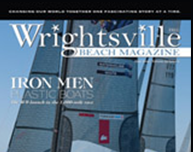Ewwww What’s That?!
BY T. Travis Brown
Beauty is in the eye of the beholder? True. The ocean provides us with a never-ending supply of beauty? Also true. Some of those beautiful things are weird weird weird? Absolutely true. You simply never know whats going to wash up on the beach. Remnants of plants and creatures from a vast area of ocean may be deposited on our shore at any time. And while many of us are familiar with charismatic critters like dolphins and whelks if you spend time beachcombing you will undoubtedly run into something that makes you stop and say: Eww whats that? For all of you who have had the occasion to ask that very question maybe even today here are a few of the gelatinous creepy and just plain peculiar life forms youre likely to see on WB. At certain times of the year this jellyfish washes up in droves almost as big as basketballs and similarly shaped. Cannonball jellies and the larger mushroom cap jellyfish can both be found in North Carolina waters. Cannonball jellies are usually more rigid than mushroom caps and have a brown band around the edge of the bell. Unlike many other species of jellyfish contact with a cannonball or mushroom cap does not cause a painful sting. In fact schools of juvenile fish (mostly jacks) baby spider crabs and other species often hide in the “bell” of cannonball jellyfish and mushroom caps. Wandering along the beach one day you may find yourself drawn to a rubbery mass of well something washed up on the beach. Many people after unsuccessfully wracking their brains come to the conclusion that this never-before-seen something must be dolphin dung. Sorry its sea pork a common name for one of several compound Ascidians (class Ascidiacea) found along our coast. Far from dolphin doo sea pork is actually a colony of tiny organisms joined together in a rubbery matrix material. The individual animals (called zooids) each have an incurrent siphon that brings in water. They filter out particles of organic matter suspended in the water and squirt the filtered water out of the colonys collective excurrent siphon. Sea wasps are a warm-water species of jellyfish commonly found along our coast in the summer months. They are small (up to 3 or 4 inches wide) with tentacles suspended from four corners of their body. The tentacles are attached to the body by distinctive paddle-shaped bases. Unlike the mushroom cap this jellyfish is capable of a painful sting. Tiny sticky poisonous spines called nematocysts are to blame for the stinging sensation we feel when stung by a jelly. If stung by a jellyfish it is best to remove any tentacle pieces with sand or a towel rinse the area with seawater vinegar works well too (not fresh water as it may cause any remaining nematocysts to fire) apply a topical pain reliever and take some sort of antihistamine. Most beachcombers are familiar with the medusa-like tentacles of sea anemones but are less familiar with the fact that when disturbed these tentacles are withdrawn and the animal resembles a fleshy blob or column. Anemones use their tentacles to gather the living and dead matter on which they feed. They attach to a hard substrate or burrow into the bottom using their pedal disc but they can also glide around and re-attach somewhere else. Anemones have separate defense tentacles called acontia that like jellyfish tentacles are armed with nematocysts. Luckily none of the species in our area are dangerous to humans. Still its probably a good idea to never touch a fleshy blob. Take a night walk on the beach and youll probably catch the skittering form of a ghost crab in the beam of your flashlight. Believe it or not these little ghosts are the most common land crabs along our beach. Youve never seen them because they dig burrows in the sand dunes and stay there during the day. At night they travel the beach searching for prey-items washed up in the wrack line sea grasses interspersed with litter refuse fragments and debris. These crabs also have the unfortunate habit of raiding the nests of sea turtles and shorebirds. But please dont blame the ghost crabs for piping plover and sea turtle population declines. Ghost crabs are a natural predator in contrast to dogs cats and especially coastal land development. Bottom-dwelling skates are cartilaginous carnivorous and oviparous fish that belong to the family of rays. Youd think all that nomenclature would be the most interesting thing about the skate what a mouthful after all but its not. The “Ewwww whats that” award goes to their egg case a tough leathery protective case that is black with four points. Long tendrils extend from each point to anchor the egg case to seaweed rocks or sand. These egg cases are also referred to as “mermaids purse ” because as all the hip fish know black goes with anything. At first glance the eggs of a whelk may appear to be the spinal chord of some unfortunate eel or other sea creature (assuming of course youre familiar with eel spinal chords). The string of disc-like egg casings often wash up in the surf and may still contain tiny whelk larvae. Whelks the largest of our sea snails are common inhabitants of our shallower waters and their shells are highly sought-after by beachcombers. They feed on shellfish by inserting their bodies between the shells of bivalves and then hammering the preys shell with their own. Eventually they chip away the shell and eat the inner soft parts of their prey. The green rubbery finger-like branches of this seaweed often wash up on our beaches looking for all the world like an innocent plant. But dont be fooled green fleece is a member of the phylum Chlorophyta (the green seaweeds) and is not native to our waters. This plant was introduced in the 1950s and was originally native to the North Pacific near Japan. Unlike vascular plants seaweeds have a holdfast in place of roots. This holdfast attaches the plant to hard substrates such as shellfish rock and piers. Green fleece is considered a pest because it chokes out native seaweeds changes subtidal plant and animal communities and can even carry away the shellfish to which it is attached during storms! A warm night wading around the back side of Wrightsville Beach flashlight in hand can provide you with many wildlife encounters. You may in fact if your timing is good spot the moving ecosystem known as a hermit crab shell. There are several species of hermits including flat-clawed long-clawed and striped hermit crabs but the diversity doesnt end there. Hermit crabs do not produce their own shells. Instead they inhabit the shells of dead mollusks such as mud snails moon snails whelks and olive shells. The shells can become home to a wonderful conglomeration of anemones barnacles slipper shells snail fur and other invertebrates.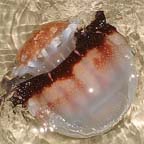 Cannonball (Cabbage head) Jelly
Cannonball (Cabbage head) Jelly Sea pork
Sea pork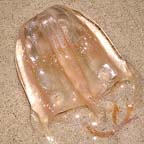 Sea Wasp
Sea Wasp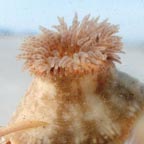 Sea Anemone
Sea Anemone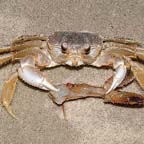 Ghost Crab
Ghost Crab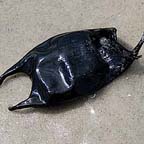 Skate Egg Case
Skate Egg Case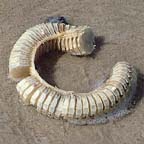 Whelk Eggs
Whelk Eggs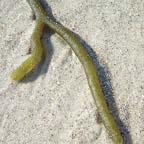 Green Fleece
Green Fleece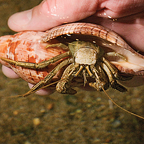 Hermit Crab
Hermit Crab
